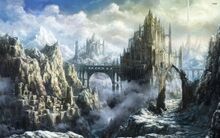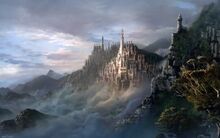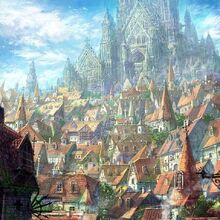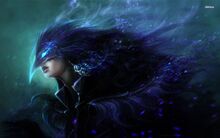"An isolated basin with a glacial lake at its heart, surrounded by mountain ranges. It's accessible only by a hellish desert road in the east, or a treacherous mountain pass in the north. That's where you will find the Immortal Queen." -Rangrim

Rule[]
Titled Ruler: High Queen
Governance: Hereditary Monarchy
Law: Feudalism
Economy: Vassalage
Census[]
Capitol: Inchorr
Lands: High Kingdom, Heart Kingdom, Horizon Kingdom
Common Folk: Humans
Geography[]
Inchorr encompasses a variety of terrains, from snow-covered mountains in the north and west to rolling hills in the east to the thick forests of the south. The great lake is at the center of the basin, which is crossed by several major rivers that provide water for crops and transport for goods. Its hills and mountains are rich with natural resources and its earth is fertile. Inchorr has a temperate climate and abundant rainfall, ideal for agriculture.
Towering above the Kulenov basin, Mount Grokala is a large northern peak with an unusually conical shape that is held sacred by a number of religions for the footprint found at its peak. The footprint, a large depression found in a rock formation on the mountain's summit, has been attributed to Bahamut, Kord, and even Bane, leading to the mountain's reverence among followers of the platinum dragon, the storm lord, and the god of war. Each year, thousands of pilgrims trek for hours up the mountain to pay their respects at the holy site.
The sacred peak of Mount Angannovsk, found in the western range, is cherished by a number of religions, particularly the followers of the Raven Queen. It is believed to be the home of the ravenkin, who dwell on the mountain in a state of eternal bliss. Mount Angannovsk is said to be among the most difficult of all religious pilgrimages, as the harsh conditions dissuade many would-be pilgrims, and the mountain is not accessible by any forms of transportation.
One of the earliest accounts of this legendary water comes from an elven poet, who describes it as a special Water of Life, giving any who drinks of it exceptionally long life. Similar stories have also been told among the natives, which brought Lake Fryatlas to prominence during early eras of exploration. According to one popular story, the human warlord Rein heard tales of the lake during his crossing in the mountains, and set out to search for eternal youth. In doing so, he discovered the Kulenov basin, and the great lake at the heart of it. Although Lake Fryatlas provides water for much of the basin, and supports the Inchorri Kingdoms as well as the elven clans, the waters do not grant eternal life. Many legends of the basin feature the fabled waters and man's eternal quest to obtain them.
The fabled Lost City of the Elves drew many human settlers to the Kulenov basin, all hoping to stumble upon its untold riches. For nearly three centuries, the myth of precious gems and gold drew adventurers to the dark southern forest, who often raided other elven tribes they found along the way. The Lost City has captivated adventurers throughout the centuries, and expeditions are still arranged to divine its location.
Inchorr is the capital of the Inchorri Kingdoms, carved into the mountainside by early human settlers in the northwestern corner of the Kulenov basin. It is ruled by Lady Yasheida, it is home to the Gray Palace of Inchorr, and it features a dun, krepost, armory, stable, constabulary, rathaus, baray, terrace, market, apothecary, forum, and an iron mine. Built by Aseir Rein, the Gray Palace of Inchorr is the residence and administrative palace for the Rein dynasty. So-called for the dark granite used to construct its massive seventy five-foot high outer duns, the Gray Palace is a tribute to the magnificence of Inchorri architecture with large audience halls, luxurious living quarters, richly landscaped gardens, baths, libraries, and sumptuous temples.

Bersk is the oldest city in the Kulenov basin, found in the northern range protecting the one and only mountain pass. It is ruled by Lady Safronova, it is home to Bersk Castle, and it features a dun, krepost, armory, stable, constabulary, rathaus, baray, terrace, market, apothecary, monastery, and an iron mine. Bersk Castle is an extraordinary mountain castle and one of the most beautiful structures in the Kulenov basin. First constructed and then massively rebuilt and extended by Zasheida Rein, Bersk Castle is a tall, imposing multi-story structure constructed of stone and wood, and featuring a brilliant white exterior and a series of beautifully curved rooftops. It is nicknamed the Storm Lord's Castle. Bersk Castle is surrounded by a confusing maze of paths leading to the keep. The walls and gates were designed to force an invading army to travel in a series of concentric circles with many dead ends before reaching the main gate. This would string out the attackers and allow the defenders to fire on the vanguard many times during the approach. The ingenious system has not been put to the test, since no army has ever made it through the mountain pass in any condition to attack the castle.

Chernin is a city set high in the western range, called the seat of royal power in the Inchorri Kingdoms. It is ruled by Lady Mironova, it is home to Chernin Castle, and it features a dun, krepost, armory, stable, constabulary, rathaus, baray, terrace, market, apothecary, forge, and an iron mine. Commissioned by Aseir Rein late in his rule, the Chernin Castle has since become the symbol of iconic Inchorri castles commonly found in legends and stories. Built into the mountainside near the town of Chernin, Aseir had intended the castle to be his retreat from public view, as he became known for his reclusive nature. Following his death, Chernin Castle became the symbol of Inchorri power in the west, from which Zasheir Rein staged many of his campaigns against the elves.

Shemov is the largest city in the Inchorri Kingdoms, found halfway between Inchorr and Lake Fryatlas. It is ruled by Lord Baranovsky, it is home to the White Fortress, and it features a dun, krepost, armory, stable, constabulary, rathaus, baray, terrace, market, apothecary, madrassa, and an iron mine. Found in Shemov, the White Fortress is a large palace complex of the former ruling family, who controlled the city state prior to Aseir Rein's conquest. Taking its name from the white hue of its walls, the White Fortress is sometimes called the "Winter Palace." Noted for its Moorish architectural style, the White Fortress features elaborate engravings and numerous examples of the interlacing patterns known as arabesques found predominantly in eastern art. Although many examples of the original style remain today, much of the fortress and its interior was reconstructed and modified after the ascension of Zasheida Rein to the throne.

Starag is the richest city in the Inchorri Kingdoms, found on the western side of Lake Fryatlas. It is ruled by Lord Murogov, it is home to the Victor's Gate, and it features a dun, krepost, armory, stable, constabulary, rathaus, dike, cothon, hammam, bazaar, apothecary, mint, and an iron mine. The Victor's Gate is the only surviving town gate of the city of Starag. A beautiful triumphal arch constructed in the eastern style, it features many columns and is surmounted by the Sign of Victory; a statue of a raven-headed warrior on horseback. It stands at the western side of the wall, facing east. Today it stands as a proud symbol of the union of Inchorr and Starag, and the Inchorri Kingdoms, and it is visited by hundreds of pilgrims from both east and west.

Marsk is a city deep in the Elirgut Wood, and the only city where elves are commonly found in the Inchorri Kingdoms. It is ruled by Lord Zakharov, it is home to the Wall of Marsk, and it features a dun, krepost, armory, stable, constabulary, rathaus, baray, terrace, market, apothecary, paper maker, and a lumber mill. The Wall of Marsk is one of the largest and most famous man-made constructions in the realms. Marskan rulers built the Wall to ward off attack from elven clans living in the Elirgut Wood. Interestingly, the Wall was not designed to keep the elves out - the Marskans knew it was all but impossible to defend such a border - it was designed to make it difficult for the elves to carry off loot, thus making raids far less profitable and thus less worth the risks involved.

Dotsch is a holy city found where the Dekovsky river meets Lake Fryatlas. It is ruled by Lord Solomonov, it is home to the Platinum Palace, and it features a dun, krepost, armory, stable, constabulary, rathaus, dike, cothon, hammam, bazaar, apothecary, stone works, and a stone quarry. The Platinum Palace is a temple in Dotsch. The Platinum Palace was constructed by an ancient ruler to serve as the royal palace and state temple. The Platinum Palace is a complex of buildings surrounded by a wall and then moat. The enclosed area measures three thousand by twenty six hundred feet. The Platinum Palace is constructed primarily of carved stone blocks. The complex is laid out in a rectangular pattern somewhat resembling that of an ancient fortress; the inner buildings are separated from the outer walls by a courtyard similar to a bailey one might find in a castle. The courtyard is filled with wooden buildings, and the stone inner structure is split into three galleries built on raised platforms. The outer galleys contain libraries, while the inner is a shrine to Kord. The galleries are topped with towers that resemble stylized beehives, the tallest reaching about one hundred forty feet in height. The buildings' walls are covered with ornate and beautiful bas relief sculptures depicting scenes from Kulenov basin legend.

Nemetsk is a border city found on the eastern side of Lake Fryatlas. It is ruled by Lord Severov, it is home to the Sun Tower of Nemetsk, and it features a dun, krepost, armory, stable, constabulary, rathaus, dike, cothon, hammam, bazaar, apothecary, caravansary, and a stone quarry. Constructed by the Nemetskan rulers, the Sun Tower of Nemetsk is one of the most extraordinary architectural achievements of the Kulenov basin. The tower is some one hundred feet in diameter, with a height of two hundred sixty feet. The exterior of the building is built of white porcelain bricks that shone like mirrors in the sunlight. At night the tower is hung from top to bottom with over one hundred lamps. The tower stands in the center of Nemetsk.

Kuzneshikha is the last city of the Inchorri Kingdoms, found in the Elirgut Wood where the Durov river meets Lake Fryatlas. It is ruled by Lady Zinaida, it is home to Yurievna’s Gardens, and it features a dun, krepost, armory, stable, constabulary, rathaus, dike, cothon, hammam, bazaar, apothecary, floating garden, and a lumber mill. Yurievna’s Gardens are a distinctive feature of Kuzneshikha. They are a great source of pride to the people, and are often described in accounts written by visitors to the city. Built by Lady Yurievna, the gardens are an ascending series of tiered platforms, not unlike a ziggurat, constructed of mud bricks and containing all manner of trees, shrubs, and vines. From a distance the gardens are said to look like a large green mountain rising from the center of the city.
The Inchorri Kingdoms are divided up into the High Kingdom, which includes Inchorr, Bersk, and Chernin, then the Heart Kingdom, which includes Shemov, Starag, and Marsk, and finally the Horizon Kingdom, which includes Dotsch, Nemetsk, and Kuzneshikha. Northern cities such as Bersk, Shemov, Starag, and western cities including Inchorr and Chernin, grew around iron mines set in the mountains. The eastern cities Dotsk and Nemetsk were founded on great stone quarries in the hills, while Marsk and Kuzneshikha in the south were founded on lumber mills.
Culture[]
The Monarchy is Inchorr's form of government where power is vested in an individual. Power passes to the High King and Queen's heir upon the current ruler's death. Inchorri monarchy is similar to despotism, but with one important difference: the monarch rules within the state's laws, while a despot is above all law. It is of course quite possible for the monarch to be a despot - but it is also possible for a monarch to be part of a political process which allows the people a good deal of freedom. The Inchorri people are still waiting for the latter.
The Mandate of Celestia says that the High King and Queen of the Inchorri Kingdoms are in power because Celestia and the gods put them there and support them. Dissent against the monarchy is not only treasonous, it's also sinful. This system greatly promotes support for the monarchy, but it is not without risk. When the Kulenov basin suffers a natural disaster - famine, flood, earthquake, hurricane, rain of frogs, or whatever - that has at times been seen as a sign that Celestia is displeased with the monarchy and has removed its mandate from them. This inspired the peasants to overthrow the sinful monarchy and replace them, though the Rein dynasty has historically proven quite capable of crushing any such revolution on the field of battle, and seizing back their mandate from the clergy.

The Inchorri army is a full-time military organization that remains in being even when the kingdom is at peace. Its soldiers are paid for their services by the monarchy and spend their time training or performing public works when not at war. The army formed when Inchorri society had grown wealthy enough to support a large number of men who did not work the fields or perform other productive work. The soldiers are usually housed in a krepost in the city states and segregated from the civilian population to minimize friction, and the monarchy provides their food, weapons, armor, and training.
Among the Elirgut woods, along the southern border of the kingdoms, dangers yet lurk. Many elven tribes are branded thieves and raiders and hunted by the Raven Guard, blood hunters from each of the four orders, sworn to the service of Inchorr. Yet the elves are far from the greatest threat in the south.
Witches who brew their immortality from the corpses of their victims are known to offer protection to isolated villages and travelers, in exchange for ritual sacrifice. Woodland spirits, known in elvish as “leshen,” are older creatures still, and they rip and tear asunder any intruders they find in their wood. And that is to say nothing of the Tigrog monster that, despite being a bedtime story told to frighten children in northern cities, is never named beneath the Elirgut trees, for fear that it will answer such a call.
Among hills in the east, the dangers are more familiar, and take the form of man. Bandits and highwaymen haunt the Kulenov Royal Road like any spirit in the west, striking caravans as they pass between the Inchorri Kingdoms and Serault. Though Nemetsk and Dotsch are well-defended, the Platinum Inquisition is forever rooting out diabolist cults responsible for foul curses and summoning fiends from the nine hells.
Shemov and Starag, despite being protected on all sides, are just as rife with peril. The Thieves’ Guild is as entrenched as faith and fealty in these cities, but they can be bought. The demons of the pit, summoned from the abyss by suicidal cults of the condemned and the cursed, have no taste for gold or precious stone, only mortal suffering and misery. Where the cults in the Horizon Kingdom turn to forbidden powers seeking salvation and life everlasting, the cults in the Heart Kingdom crave only death and destruction.
Finally, in the High Kingdom, where the Raven Guard has long since burned any cultists at the stake, the threats are found in what lies beneath. Though strong trade with the dwarven clans in the mountains supports the Inchorri Kingdoms, not all caves lead to warm dwarven hearths. Hundreds of caves around Inchorr, Bersk, and Chernin lead deep into a darkness from which man does not return. Aberrations of the Underdark lay claim to those mountains, and it is not uncommon to hear travelers’ speak of companions lured away into the dark by dreams, visions, or other madness. Further, the dead do not rest in peace in the western mountains; they sleep lightly, and the slightest disturbance will rouse them. There are more hauntings in the High Kingdom than in the Heart and Horizon kingdoms combined.
History[]
Situated in a basin surrounded by impassable mountains, Inchorr was home to Aseir Rein, High King of the Inchorri Kingdoms. At its peak, the warriors of Inchorr control a territory spanning nine city states spread out over twenty three hundred leagues. The city supports itself through taxes, forced labor, and royal levies; at times, to finance his military, Aseir traded slaves, iron and timber with the dwarves in the mountains. It is also supported by extorting tribute from neighboring cities and kingdoms, making Inchorr one of the wealthier cities of her time.
Aseir Rein is unquestionably one of the great warlords of his time. In seventeen short years he marched his army to victory after victory across the Kulenov basin, conquering every people he could reach. This extraordinary man conquered Starag, Bersk, Shemov, Chernin, Nemetsk, Dotsk, and Marsk. But Aseir's conquests allowed Inchorri culture to spread across the basin, and Inchorr would become the hub of culture, art and science for centuries to come. With the exception perhaps of one or two religious leaders, no single man has had such a great effect upon the region as did Aseir Rein; Yasheira Rein's grandfather.
It is virtually impossible to overstate the military genius of Zasheir Rein; he is one of the most brilliant generals of his time. He moves his troops with astounding rapidity, and he always knows exactly where to strike in order to cause the most damage. Domestically he turned out to be a decent, imaginative ruler and Inchorr has flourished under his control, until his endless wars sapped her strength and will to fight. An army general to his core, when Yasheira's father saw the breadth of his domain, he wept, for there were no more lands to conquer.
Zasheida Rein rules Inchorr and oversaw a great expansion of the Inchorri Kingdoms, adding hundreds of leagues of territory through conquest and shrewd diplomacy. A beautiful and intelligent woman, she beguiled and outwitted the best minds of the Kulenov basin, making her court one of the centers of enlightenment thinking on the continent. Zasheida is one of the greatest rulers in Inchorri history.
Zasheida's reign is notable for royal expansion. Most important were the securing of the northern pass, the annexation of Kuzneshikha, and the expansion into the steppes beyond the Elirgut Wood. This permitted the protection of Inchorri agricultural settlements in the south and the establishment of trade routes through the mountains. Zasheida's partitioning of elven territory also helped bring Inchorri order to the realm.
Zasheida implemented many public work projects throughout Inchorr and its holdings. She also increased internal and foreign trade. On the other hand, she has done little to improve the lot of the Inchorri peasants; in fact, their lives have grown distinctly harder during her reign. Yasheira's mother is proof that a woman can be smart and tough enough to rival even Aseir Rein on the throne.

Yet the Inchorri Kingdoms’ present ruler may be the best known of the Rein dynasty. Yasheira Rein, better known as Demonsbane, rules as the Immortal Queen from the throne given to her little sister Yasheida Rein when the king and queen thought their eldest daughter lost. Returning almost ten years after her disappearance, Demonsbane seized the throne from Yasheida at the point of her sword, the mastercrafted Icebreaker, which is said to bear the soul of a frost titan. Yasheida was allowed to rule over Inchorr as lady of the city, while the Immortal Queen set out seeking an enemy worthy of her.
Tales of the Immortal Queen and her sword Icebreaker can be heard in distant Serault, and even far away Bracada, recounting her victories over monsters and men. According to some, the Immortal Queen spent her ten missing years battling a demon in another world, earning the name Demonsbane when she struck down her foe and cast his remains on a battlefield that no longer exists. Yet others say she was fooled by a pirate queen and a metal man, tricked into slaying holy men of the platinum dragon and an innocent seer in his tower. It has been said that the Immortal Queen’s bodyguard, a powerful champion of the platinum dragon, is also her nanna and her minder, but most agree that such is a jester’s tale.